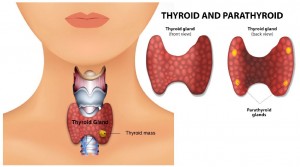Thyroid Cancer
What is Thyroid Gland?
The thyroid gland is a gland in the neck. The thyroid gland is shaped like a butterfly and is located on the front of the neck, underneath the voice box (larynx). This gland has two parts (lobes). The lobes are separated by isthmus (a thin tissue).
Four or more parathyroid glands are located behind the thyroid gland. The parathyroid glands are located on the surface of the thyroid gland and produce parathyroid hormones. Parathyroid hormones help the body maintain a healthy calcium level.
Thyroid gland has two types of cells that produce hormones:
1) Follicle cells. The follicle cells produce thyroid hormones that affect heart rate, body temperature, and energy levels.
2) Cell C. Cell C produces calcitonin (a hormone that helps control calcium levels in the blood).
The healthy thyroid gland is a little bigger than the size of a 20 cent coin. These glands cannot be felt through the skin.
Thyroid disease may be significant as two types of disease groups, either because of their function or nodes (cancer or not cancer) in the neck.
What is Thyroid Cancer?
Thyroid cancer begins when the thyroid gland becomes abnormal, grows uncontrollably, and forms a mass of tissue called tumor or tumor.
Tumors in thyroid are often named nodules. However, thyroid nodules may be benign (non-cancerous) or malignant (cancerous). Different features of the benign nodules with malignant nodules are described below.
1) Nodul benigna:
- Usually life-threatening (depending on the location and size, may be large enough to cause narrowing of the airways that result in life-threatening conditions)
- Does not penetrate the tissue around it
- Does not spread to other parts of the body
- Usually do not need to be discarded
2) Malignant nodules:
- Sometimes it may be life threatening
- Can penetrate the surrounding tissues and organs
- Can spread to other parts of the body
- It can often be removed or destroyed, but sometimes the cancer reappear
Types of Thyroid Cancer
Types of thyroid cancer are based on how cancer cells look through a microscope.
Thyroid cancer cells can spread to the blood vessel (which connects all body tissues) and thus form a new tumor and destroy the organs affected by these cancer cells.
The following are the four major types of thyroid cancer:
• Papillary Tumor
• Follicle Tumors
• Medicinal Tumor
• Anaplastic Tumors
Papillary Tumor
This type of tumor develops in cells that produce thyroid hormones that contain iodine.
This cancer usually grows slowly. However, this can spread to the lymph nodes in the neck or near them.
Most of this type of tumor can be successfully treated by the doctor even though the cells have spread to nearby lymph nodes. (Depending on its sub type and perfection of surgery, as well as the stage of illness).
Follicle Tumors
This tumor also develops in cells that produce hormones that contain iodine, and have a thin tissue layer around it named capsules.
Many follicular tumors can be restored but may be difficult to control if the tumor penetrates into the bloodstream or grows over the capsule into the adjacent structure of the neck. (Depending on its sub type and perfection of surgery, as well as the stage of illness).
Medullary Tumors
These types of tumors affect thyroid cells that produce hormones that do not contain iodine.
These types of tumors grow slowly but are more difficult to control than papillae and follicles. The cancer spreads to other parts of the body.
Anaplastic Tumors
This type of tumor is the fastest growing thyroid tumor.
This highly abnormal cancer cell spreads quickly to other parts of the body.
Risk Factors for Thyroid Cancer
Listed below are several factors that may increase the risk of thyroid cancer, but no one knows the exact cause of thyroid cancer.
I. Exposed to radiation: Individuals exposed to high levels of radiation are expected to be more likely to have thyroid cancer than other individuals. An important source of radiation is the treatment of X-rays. For example, a person who always uses X-ray diagnostic even with a low dose of radiation increases the risk of developing thyroid cancer.
II. Gender: Women are more susceptible to thyroid cancer than men. In Peninsular Malaysia, as reported by Malaysian Cancer Statistics – Data and Figures, Peninsular Malaysia, 2006, women are three times more likely to have thyroid cancer than men.
III. Lineage: Certain types of thyroid cancer may be inherited.
IV. Age: Thyroid cancer can occur in any age group, but is more likely after age 30, and the risk increases in older individuals.
V. Iodine is not enough in the diet: Thyroid glands require iodine to produce thyroid hormones. We can reduce the risk if iodine is one of our food ingredients. Seafood is an example of food that contains iodine.
VI. History of goiter on the person or family: Goiter is a benign nodule (non-cancerous) thyroid. Individuals who experience goiter are likely to have thyroid cancer.
If one has a risk factor or more, this does not mean that he or she will get thyroid cancer. Most individuals with some risk factors do not have thyroid cancer. However, the obvious is non-infectious thyroid cancer.
Thyroid Cancer Symptom
In the early stages, thyroid cancer often does not show symptoms. As thyroid cancer grows, the symptoms may result in:
- The existence of a lump on the front of the neck and can be felt.
- Rasping or hard talking in a normal voice.
- Lymph nodes are swollen, especially in the neck. The lymph nodes are oval and contain many tissues that act as filters for liquids called lymph and function to remove cell waste and help the body fight infection.
- Hard to swallow or breathe.
- Pain in the throat or neck continuously.
